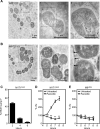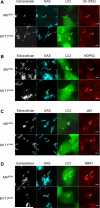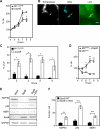The globally disseminated M1T1 clone of group A Streptococcus evades autophagy for intracellular replication
- PMID: 24331465
- PMCID: PMC3918495
- DOI: 10.1016/j.chom.2013.11.003
The globally disseminated M1T1 clone of group A Streptococcus evades autophagy for intracellular replication
Abstract
Autophagy is reported to be an important innate immune defense against the intracellular bacterial pathogen Group A Streptococcus (GAS). However, the GAS strains examined to date belong to serotypes infrequently associated with human disease. We find that the globally disseminated serotype M1T1 clone of GAS can evade autophagy and replicate efficiently in the cytosol of infected cells. Cytosolic M1T1 GAS (strain 5448), but not M6 GAS (strain JRS4), avoids ubiquitylation and recognition by the host autophagy marker LC3 and ubiquitin-LC3 adaptor proteins NDP52, p62, and NBR1. Expression of SpeB, a streptococcal cysteine protease, is critical for this process, as an isogenic M1T1 ΔspeB mutant is targeted to autophagy and attenuated for intracellular replication. SpeB degrades p62, NDP52, and NBR1 in vitro and within the host cell cytosol. These results uncover a proteolytic mechanism utilized by GAS to escape the host autophagy pathway that may underpin the success of the M1T1 clone.
Copyright © 2013 Elsevier Inc. All rights reserved.
Figures




Comment in
-
Streptococcus pyogenes escapes from autophagy.Cell Host Microbe. 2013 Dec 11;14(6):604-6. doi: 10.1016/j.chom.2013.11.012. Cell Host Microbe. 2013. PMID: 24331458
Similar articles
-
Streptococcus pyogenes escapes from autophagy.Cell Host Microbe. 2013 Dec 11;14(6):604-6. doi: 10.1016/j.chom.2013.11.012. Cell Host Microbe. 2013. PMID: 24331458
-
Endopeptidase PepO Regulates the SpeB Cysteine Protease and Is Essential for the Virulence of Invasive M1T1 Streptococcus pyogenes.J Bacteriol. 2018 Mar 26;200(8):e00654-17. doi: 10.1128/JB.00654-17. Print 2018 Apr 15. J Bacteriol. 2018. PMID: 29378883 Free PMC article.
-
The Emergence of Hypervirulent M1T1 Clone of Group A Streptococcus via Genetic Recombination and Host Selection.Curr Issues Mol Biol. 2019;32:435-472. doi: 10.21775/cimb.032.435. Epub 2019 Jun 5. Curr Issues Mol Biol. 2019. PMID: 31166177 Review.
-
IgG protease Mac/IdeS is not essential for phagocyte resistance or mouse virulence of M1T1 group A Streptococcus.mBio. 2013 Jul 30;4(4):e00499-13. doi: 10.1128/mBio.00499-13. mBio. 2013. PMID: 23900173 Free PMC article.
-
Molecular insight into invasive group A streptococcal disease.Nat Rev Microbiol. 2011 Sep 16;9(10):724-36. doi: 10.1038/nrmicro2648. Nat Rev Microbiol. 2011. PMID: 21921933 Review.
Cited by
-
Intracellular Streptococcal Uptake and Persistence: A Potential Cause of Erysipelas Recurrence.Front Med (Lausanne). 2019 Jan 29;6:6. doi: 10.3389/fmed.2019.00006. eCollection 2019. Front Med (Lausanne). 2019. PMID: 30761303 Free PMC article.
-
More Than Skin Deep: Autophagy Is Vital for Skin Barrier Function.Front Immunol. 2018 Jun 25;9:1376. doi: 10.3389/fimmu.2018.01376. eCollection 2018. Front Immunol. 2018. PMID: 29988591 Free PMC article. Review.
-
How to rewire the host cell: A home improvement guide for intracellular bacteria.J Cell Biol. 2017 Dec 4;216(12):3931-3948. doi: 10.1083/jcb.201701095. Epub 2017 Nov 2. J Cell Biol. 2017. PMID: 29097627 Free PMC article. Review.
-
Cationic antimicrobial peptide resistance mechanisms of streptococcal pathogens.Biochim Biophys Acta. 2015 Nov;1848(11 Pt B):3047-54. doi: 10.1016/j.bbamem.2015.02.010. Epub 2015 Feb 17. Biochim Biophys Acta. 2015. PMID: 25701232 Free PMC article. Review.
-
The crosstalk between bacteria and host autophagy: host defense or bacteria offense.J Microbiol. 2022 May;60(5):451-460. doi: 10.1007/s12275-022-2009-z. Epub 2022 Apr 29. J Microbiol. 2022. PMID: 35486304 Review.
References
-
- Banks DJ, Porcella SF, Barbian KD, Beres SB, Philips LE, Voyich JM, DeLeo FR, Martin JM, Somerville GA, Musser JM. Progress toward characterization of the group A Streptococcus metagenome: complete genome sequence of a macrolide-resistant serotype M6 strain. J. Infect. Dis. 2004;190:727–738. - PubMed
-
- Berge A, Bjorck L. Streptococcal cysteine proteinase releases biologically active fragments of streptococcal surface proteins. J. Biol. Chem. 1995;270:9862–9867. - PubMed
-
- Birmingham CL, Smith AC, Bakowski MA, Yoshimori T, Brumell JH. Autophagy controls Salmonella infection in response to damage to the Salmonella-containing vacuole. J. Biol. Chem. 2006;281:11374–11383. - PubMed
-
- Carapetis JR, Steer AC, Mulholland EK, Weber M. The global burden of group A streptococcal diseases. Lancet Infect. Dis. 2005;5:685–694. - PubMed
Publication types
MeSH terms
Substances
Grants and funding
LinkOut - more resources
Full Text Sources
Other Literature Sources
Molecular Biology Databases
Miscellaneous

